Ronald Acuña Jr. is a three-time All-Star, the only player in history with 120 homers and 120 steals in his first 550 games, and one of only two players in the game with power, speed and arm strength at elite levels. The Braves’ right fielder is as super as superstars get in MLB. And yet, we have never seen Acuña this good.
The 2023 season began with its identifiers preset: the year of the new rules, the platform season into free agency of Shohei Ohtani and the encore year of Aaron Judge after his 62 home runs. One quarter of the way into the season, Acuña, 25, has broken through more than anyone else as its defining player, the way Judge was for 2022.
He is so good that you can break the National League MVP race into two groups: Acuña and the field. And Acuña is far ahead. His 2.7 WAR blows away everyone else in the league. Dansby Swanson of the Cubs, a guy with three home runs, is next at a distant 1.9.
“This is the best he’s ever been, when you consider his total game. Absolutely,” says Braves manager Brian Snitker. “He’s always been talented, but remember he got to the big leagues so young—at 20. He’s maturing as a player and a person. He’s a father now, and I think that’s a part of it.
“The other thing a lot of players go through is when you lose the game, the way he did with his [2021] knee injury, you don’t take the game as lightly. There’s no doubt in my mind when it comes to his total game, he’s better than ever.”
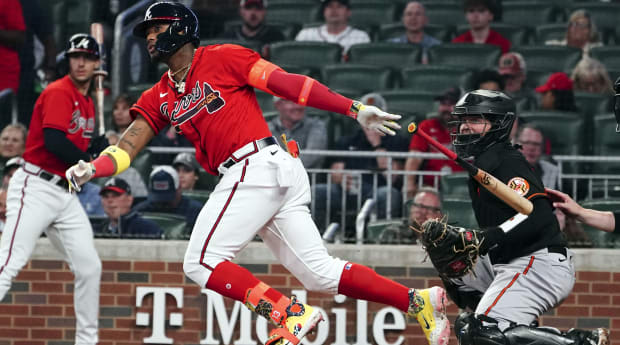
AP
Hitting .346, Acuña leads the league in runs (36), hits (54), stolen bases (17), OBP (.437), OPS (1.014), OPS+ (174) and total bases (90). He has played in every game. He could slow down from his pace and still join Rickey Henderson in 1990 and Joe Morgan in ’76 as the only players to hit .300 with 25 homers and 60 stolen bases. Henderson and Morgan were MVPs in those years.
Why is this The Year of Acuña? Let us count the ways.
1. His knee is healthy.
This is the biggest reason. Acuña blew out his knee July 10, 2021. He returned last season, but a return to the lineup does not mean a return to full form.
A 2015 study by former Dodgers trainer Stan Conte found that hitters who tore the ACL of their back leg lost 12.3% off their batting average when they returned. In ’22, Acuña’s batting average dropped from .283 to .266, and his slugging cratered from .596 to .413. Quite simply, Acuña last season did not have the full strength or full confidence in his back leg while hitting. For a guy with the strongest hip torque in baseball, he was missing a huge part of his game.
It is clear from the swings that Acuña is taking this season that he is playing at full knee strength. He is driving his back side through the baseball and rotating his hips with the speed he had before the knee injury.
Look at key moments in these two swings on fastballs to the same area: a flyout to right field last Sept. 20 (on the left) and a 470-foot home run last week (on the right):
Foot Strike
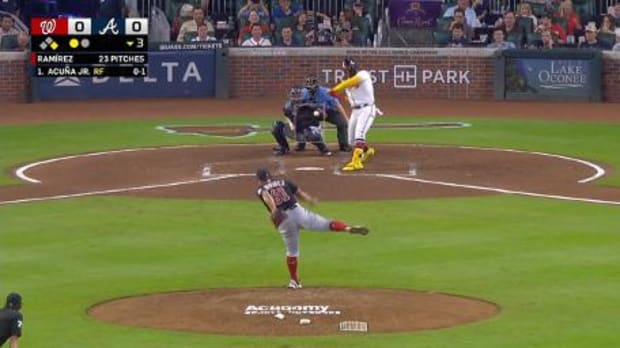
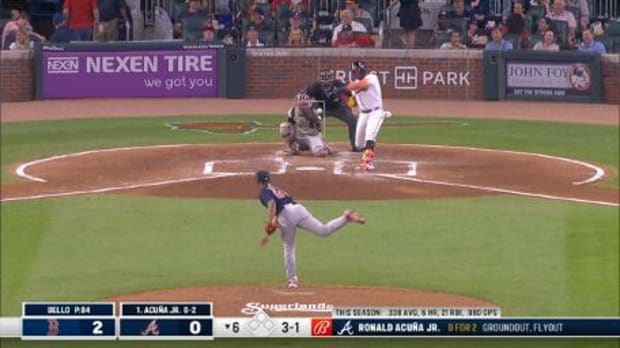
Last year the back foot is starting to slip behind him. This year, the back foot is solid, the back knee is beginning to drive toward the baseball (not down) and the hips are already opening up.
Contact
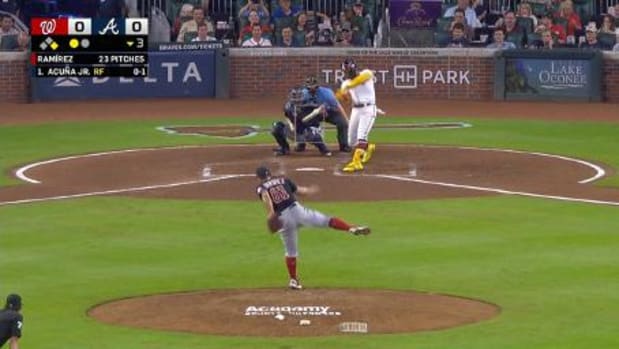

Last year, the feet were in a closed stride position. He has left his back side behind him. Note the difference in his belt buckle and pants stripe—you can see this year the greater turn, which tells you he has fully fired his hips. The foot stride is neutral (feet in line), creating better balance.
Extension
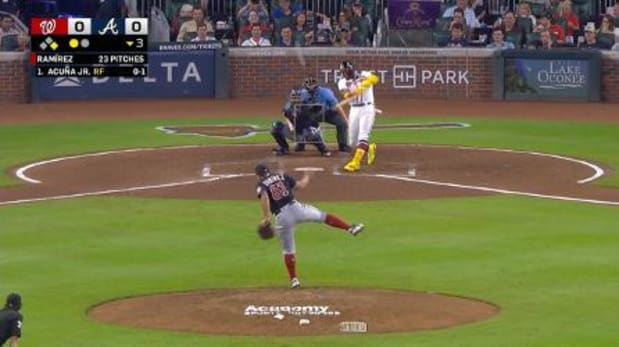
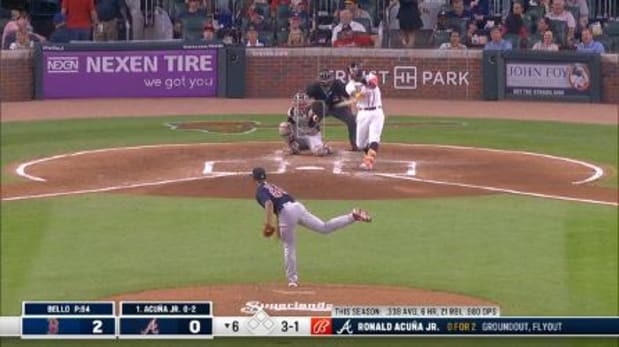
In 2022, look at Acuña’s arms—they are bent. That’s because without clearing his hips and not getting his backside through, he doesn’t have enough room for his arms to extend. He must compensate with that “chicken wing” move to save his swing. This year, you can see how straight his arms are. Now that’s “getting through” the baseball.
2. He is crushing fastballs.
Teams scouting Acuña last year noticed he wasn’t getting through baseballs, so they attacked him with 52% fastballs (not including cutters). They have junked that scouting report:
Acuña vs. Fastballs (not including cutters)
| Year | Pct.. | Avg. | SLG |
|---|---|---|---|
2022 |
52% |
248 |
..400* |
2023 |
47% |
.426+ |
.765+ |
3. The ban on shifts.
Who knew a right-handed slugger would be the beneficiary of the ban on shifts? Acuña himself pointed out the ban on shifts has made the biggest difference for him among the new rules. Why? Acuña is a heavy groundball hitter who saw 60% shifts last year. The numbers back him up:
Acuña Groundballs
| Year | Pct. | Avg. |
|---|---|---|
2022 |
47.7% . |
268 |
2023 |
54.1%+ |
.333 |
4. Cutting down on strikeouts.
In each of his first five seasons in MLB, Acuña struck out around or over the MLB average. This year he has cut his whiff rate from 23.6% to 13.1%, well below the MLB average. Among qualified hitters, only Luis García of Washington has cut his strikeout rate by more.
It’s not because Acuña is chasing less; that rate has barely changed. It’s because he has become a two-strike monster, hitting .243 in those counts after averaging .172 in his career.
Only two players rank in the 90th percentile in exit velocity and strikeout rate: Acuña and Vlad Guerrero Jr. It is the first time in Acuña’s career that he has achieved that rare combination of hitting the ball so hard and so often.
Acuña is the prototype of what scouts for years called “a five-tool player.” Scouts judge a player on hitting for average, hitting for power, speed, throwing arm and fielding. They assign grades to those tools simply by way of judgment.
We also have definitive metrics now. The building blocks teams look for now include measurables: how hard you hit the ball and how fast you can run. Acuña rates in the 88th percentile among all major leaguers in exit velocity (97) and sprint speed (88). Only six other players reach those power/speed thresholds: Corbin Carroll, Ezequiel Durán, Riley Greene, Julio Rodríguez, Jack Suwinski and Bobby Witt Jr.
But when you also look at arm strength, only two players from that power-speed group grade just as highly in throwing arm percentile: Acuña (100) and Rodriguez (92). That’s it. That’s it when it comes to an elite combination of power, speed and arm strength.
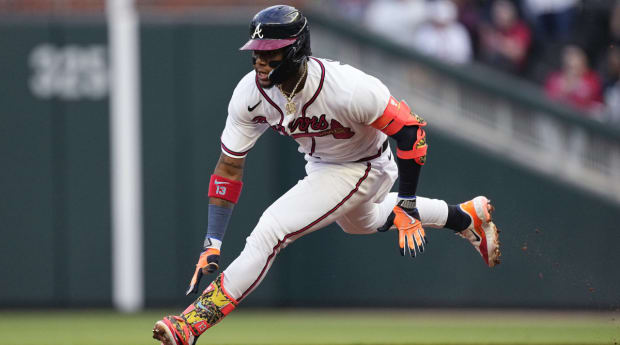
AP
If there is one knock on Acuña, at least when it comes to measurables, it’s his defense. StatCast rates him only in the 15th percentile for outfield jumps and just the second percentile for outs above average. Those numbers are hard to square for someone who has been a center fielder and has elite speed and an elite arm. When I mentioned those defensive metrics to Snitker, he reacted as if he just inadvertently took a sip of sour milk.
“Aw, don’t give me that,” Snitker says. “I’ve given up on those defensive numbers. I tell our analytics guys, ‘I don’t care.’ Really, I don’t care what they say. I know what I see. Ronnie is an elite defender. I watch him every night. He is a Gold Glove defender. That’s what the eye test tells me. That’s what I know.”
Acuña has never won the MVP. He finished fifth in 2019, when he hit 41 homers and won the stolen base crown with 37 bags, falling just three steals short of a 40–40 season. As eye-catching as those numbers might be, Acuña struck out 188 times that year. This year he has as many walks as strikeouts (24). He is better than he’s ever been.







